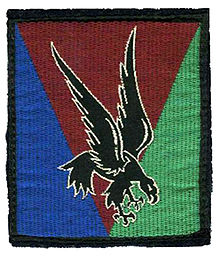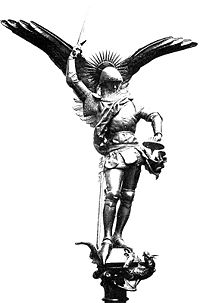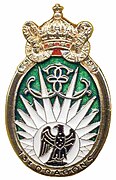
A paratrooper is a military parachutist—someone trained to parachute into a military operation, and usually functioning as part of an airborne forces. Military parachutists (troops) and parachutes were first used on a large scale during World War II for troop distribution and transportation. Paratroopers are often used in surprise attacks, to seize strategic objectives such as airfields or bridges.
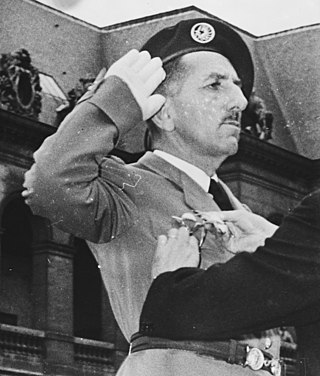
Jacques Émile Massu was a French general who fought in World War II, the First Indochina War, the Algerian War and the Suez crisis. He led French troops in the Battle of Algiers, first supporting and later denouncing their use of torture.
Marcel Bigeard, personal radio call-sign "Bruno", was a French military officer and politician who fought in World War II, the First Indochina War and the Algerian War. He was one of the commanders in the Battle of Dien Bien Phu and is thought by many to have been a dominating influence on French "unconventional" warfare thinking from that time onwards. He was one of the most decorated officers in France, and is particularly noteworthy because of his rise from being a regular soldier in 1936 to ultimately concluding his career in 1976 as a Lieutenant General and serving in the government of Valéry Giscard d'Estaing.

The 1st Marine Infantry Parachute Regiment or 1er RPIMa is a unit of the French Army Special Forces Command, therefore part of the Special Operations Command.

The 2nd Marine Infantry Parachute Regiment is an airborne regiment of the Troupes de Marine created in 1947. The regiment is heir to the traditions of the 2nd Colonial Commando Parachute Battalion 2eB.C.C.P. As of 2008, the regiment is stationed at Saint-Pierre, Réunion.

The 3rd Marine Infantry Parachute Regiment is a one of the airborne force regiment of the Troupes de Marine. It is heir to the 3rd Colonial Commando Parachute Battalion created in 1948 and the 3rd Colonial Parachute Regiment. The regiment is part of the 11th Parachute Brigade.
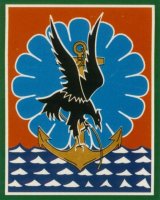
The 11th Parachute Brigade is a one of the French Army's airborne forces brigade, predominantly light infantry, part of the French paratrooper units and specialized in air assault, airborne operations, combined arms, and commando style raids. The brigade's primary vocation is to project in emergency in order to contribute a first response to a situational crisis. An elite unit of the French Army, the brigade is commanded by a général de brigade with headquarters in Balma near Toulouse. The brigade's soldiers and airborne Marines wear the red beret (amaranth) except for the Legionnaires of the 2ème REP who wear the green beret.

The 6th Marine Infantry Parachute Regiment is an airborne infantry unit of the French Army.

The 8th Marine Infantry Parachute Regiment is an airborne regiment of the Troupes de Marine. The 8e RPIMa was created on 28 February 1951 and the men wear the red beret. It is part of the 11th Parachute Brigade.
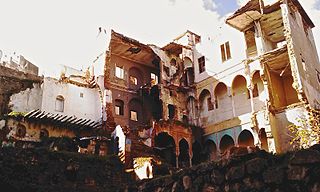
The Battle of Algiers was a campaign fought during the Algerian War. It consisted of urban guerrilla warfare and terrorist attacks carried out by the National Liberation Front (FLN) against the French authorities in Algiers, and by the French authorities, army, and French terrorist organizations against the FLN. Both sides targeted civilians throughout the battle. The conflict began with attacks by the FLN against the French forces and Pieds-Noirs followed by a terrorist attack on Algerian civilians in Algiers by a group of settlers, part of the terrorist group "La Main Rouge", aided by the police. Reprisals followed and the violence escalated, leading the French Governor-General to deploy the French Army in Algiers to suppress the FLN. Civilian authorities gave full powers to General Jacques Massu who, operating outside legal frameworks between January and September 1957, eliminated the FLN from Algiers. The use of torture, forced disappearances and illegal executions by the French later caused controversy in France.
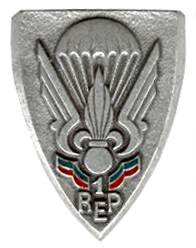
The 1st Foreign Parachute Regiment was an airborne regiment of the Foreign Legion in the French Army which dated its origins to 1948. The regiment fought in the First Indochina War as the three-time reconstituted 1st Foreign Parachute Battalion, the Suez Crisis and Algerian War, but was dissolved along with the 10th Parachute Division and 25th Parachute Division following the generals' putsch against part of the French government in 1961.

The 9th Parachute Chasseur Regiment was an airborne unit of the French Army that was part of the French Airborne Units and all three histories of the 10th Parachute Division, 25th Parachute Division and the 11th Parachute Brigade. It was formed during the Algerian War and fought its most notable engagement at the Battle of Frontiers in 1958 at Souk Ahras during which the sacrifice of Captain's Beaumont 3rd combat company earned naming the garrison of the 9th Parachute Chasseur in his honor. During the Algerian War, the 9th Parachute Chasseur Regiment relieved the 1st Parachute Chasseur Regiment and became part of the 25th Parachute Division. The regiment did not take part in the 1961 Algiers Putsch. The regiment took part in numerous overseas operations before merging in 1999. The regiment was the heir to the traditions, battle honours and decorations of the 9th Infantry Regiment created during the Ancien Régime.
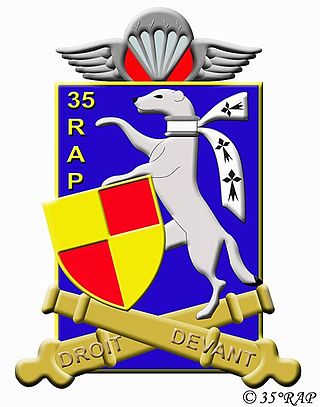
The 35th Parachute Artillery Regiment is the only airborne artillery unit of the French Army forming the air artillery component of the 11th Parachute Brigade. It is based in Tarbes together with the air cavalry, the 1st Parachute Hussar Regiment.

The 17th Parachute Engineer Regiment is heir to the traditions of the 17th Colonial Engineer Regiment which illustrated itself during World War II. It is the only airborne engineer unit of the French Army forming the engineering component of the 11th Parachute Brigade and secures all the specific airborne engineering missions relative to para assaulting at the level of deep reconnaissance as well as operations relative to para demining and handling explosives. The regiment has been present non-stop since 1975 on all theatres of operations. For its various combat operational deployments, the 17e RGP was cited 3 times at the orders of the armed forces, 2 times at the orders of the armed forces corps, and three of its combat companies cited at the orders of the armed forces in addition to armed forces corps.

The 1st Parachute Chasseur Regiment is the oldest and among the most decorated Airborne forces regiments of the French Army. Established in the French Army in 1943 and formerly part of the French Air Force since 1937, the chasseur distinguished its Regimental Colors during the campaigns of the Liberation of Paris, the First Indochina War in 1947, 1950, 1953, 1954 and the Algerian War. This elite regiment is part of the 11th Parachute Brigade.

The 3rd Foreign Parachute Battalion was parachute battalion of the Foreign Legion formed based on the Parachute Instruction Company (C.I.P) of the 7th combat company of the 2nd Battalion of the 1st Foreign Infantry Regiment.

The 25th Parachute Division was an airborne division of the French Army, part of the French Airborne Units. Consisting mainly of air infantry specialized in airborne combat, air assault and established in 1956; the Parachute Division took principal part only in the Algerian War.
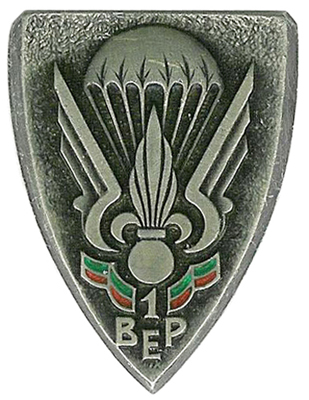
The 1st Foreign Parachute Battalion was a parachute battalion of the Foreign Legion formed from the Parachute Company of the 3rd Foreign Infantry Regiment.
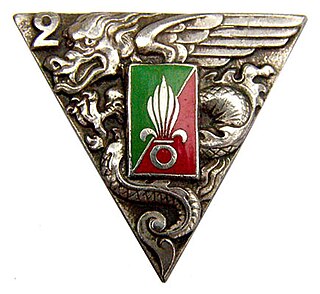
The 2nd Foreign Parachute Battalion was a parachute battalion of the Foreign Legion in the French Army initially composed of volunteers of the 4th Demi-Brigade of the Foreign Legion.
